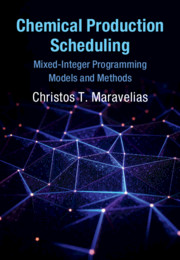Book contents
- Chemical Production Scheduling
- Cambridge Series in Chemical Engineering
- Chemical Production Scheduling
- Copyright page
- Dedication
- Contents
- Preface
- Part I Background
- Part II Basic Methods
- Part III Advanced Methods
- 8 Network Environment: Extensions
- 9 Continuous Processes
- 10 Periodic Scheduling
- 11 Multiperiod Blending
- Part IV Special Topics
- Index
- References
9 - Continuous Processes
from Part III - Advanced Methods
Published online by Cambridge University Press: 01 May 2021
- Chemical Production Scheduling
- Cambridge Series in Chemical Engineering
- Chemical Production Scheduling
- Copyright page
- Dedication
- Contents
- Preface
- Part I Background
- Part II Basic Methods
- Part III Advanced Methods
- 8 Network Environment: Extensions
- 9 Continuous Processes
- 10 Periodic Scheduling
- 11 Multiperiod Blending
- Part IV Special Topics
- Index
- References
Summary
In this chapter, we discuss models for the scheduling of continuous processes. We use the sets, subsets, and parameters introduced in Chapter 7 to represent a facility. To simplify the presentation, we consider problems with the following assumptions: (1) dedicated storage vessels; (2) no storage in processing units; (3) instantaneous and resource unconstrained material transfers; (4) no unit deterioration; and (5) demand that can be satisfied (no backlogs). We start, in Section 9.1 with some background and a discussion of the main differences between batch and continuous processing. In Section 9.2, we present the basic, STN-based, model; and we close, in Section 9.3, with numerous extensions including modeling for startups and shutdowns, transitions between tasks, and time delays.
- Type
- Chapter
- Information
- Chemical Production SchedulingMixed-Integer Programming Models and Methods, pp. 216 - 232Publisher: Cambridge University PressPrint publication year: 2021

